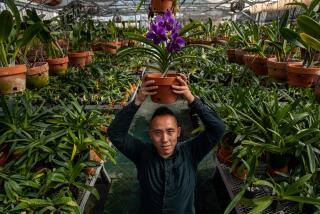Orchids Can Be Anyone’s Passion
- Share via
Surprisingly easy to grow, orchids brighten winter interiors.
Small wonder that indoor gardeners sound nothing less than passionate when discussing these dazzling exotics.
Passion is what orchids are all about. The word itself comes from the Greek “orchis,” writes Rebecca Sawyer-Fay in an article in the November issue of Country Living, and was believed to have aphrodisiac powers.
In Victorian times, to satisfy European demand for orchids, plant hunters prowled large tracts of Southeast Asian and the Brazilian rain forests, searching for flamboyant Cattleya and Oncidium subspecies.
In the 1830s, English physician and botanist Nathaniel Bagshaw Ward revolutionized plant collecting by inventing portable glass-encased containers resembling modern terrariums. In the Wardian cases, delicate specimens plucked from the world’s remote regions traveled safely into the homes of Britain’s upper classes.
Thanks to Ward, orchid fever soon spread to America.
Interest peaked again during World War II, when thousands of specimens were sent from England to the United States for safekeeping. With supplies dramatically increased, orchid collecting was no longer a hobby reserved for the wealthy. Costs dropped further in the 1960s, when scientists began cloning the plants.
Thus, while collectors once paid thousands of dollars for rare orchids, hobbyists now spend as little as $25 per specimen.
The choices available are nothing short of staggering. More than 100,000 orchid hybrids have been created from at least 25,000 distinct species.
All are members of the clan Orchidacae--the world’s largest flowering-plant family. Indigenous to every continent except Antarctica, orchid plants can grow as tall as 25 feet or as small as a thumbnail. The one trait all orchids share is the fusion of the male portion of the flower (the stamen) and the female portion (the pistil). On each blossom, three stamens and three pistils join together on a single column.
Orchids may be divided into four groups, according to how they grow in the wild.
Epiphytes, nonparasitic air plants, grow in trees, while lithophytes cling to rocks. Saprophytes flourish in decaying vegetation. Terrestrials anchor themselves in soil or sand. Because most orchids are epiphytes, they can be grown in tree bark (fir or redwood), crumbled charcoal, pebbles, tree-fern fiber or slabs of cork.
Many orchids boast delightful fragrance (vanilla planifolia is the source of the vanilla bean). Others emit an odor so unpleasant as to make the plants inappropriate for the home (these are rarely available on the marketplace).
The techniques that orchids use to attract pollinators are so convoluted, even bizarre, that Charles Darwin expressed doubt that the “world’s most imaginative man with unlimited time at his disposal” could have dreamed them up.
Perhaps it is this complexity that has caused many gardeners and houseplant enthusiasts to view orchids as “difficult.” According to Ned Nash, director of education and conservation at the American Orchid Society, “worrying too much” is the No. 1 impediment to raising orchids successfully.
“Anyone can grow a Phalaenopsis,” Nash believes. “It’s easier than an African violet.”
Commonly called moth orchids, pot-grown Phalaenopsis orchids flaunt spectacular sprays of solid and variegated pink, white, yellow or red blossoms.
Plants grow readily at 70 to 80 degrees Fahrenheit during the day and a minimum 60 degrees Fahrenheit at night.
Soil should be kept medium-moist (too much water will lead to rot).
Bimonthly application of 20-20-20 fertilizer will encourage an extended period of bloom that can persist up to three months.
And the plants are long-lived. At the American Orchid Society headquarters, in West Palm Beach, Fla., some Phalaenopsis orchids are in their third decade.
The society recommends buying only nursery-propagated plants, which will help discourage pilferage of endangered species.
Plants should be secure in the pot and weed-free, with firm, succulent leaves and visible flower buds.
Although local garden centers are good sources for beginners, experienced collectors may want to consider a mail-order source.






